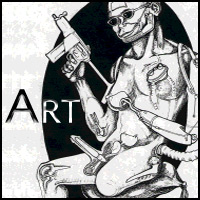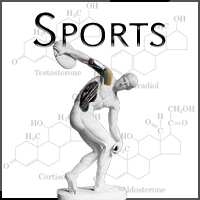
Cyborgization of SportEli Schulman The cyborgization of sport has come to the forefront of the national conscious in recent years. With the Balco scandal and blood doping accusations levied against both Lance Armstrong and Floyd Landis, America has inherited the media's ethical ideals on the subject. But the question is, are these ideals correct? Should steroids be banned in baseball or are they just the next logical step in the natural human need for progression? Why should people who are "naturally gifted" be stronger, faster, and better than the average Joe? Why can't the "Monday morning quarterback" strap on a prosthetic arm and be the "any given Sunday" quarterback? Are anabolic steroids really that detrimental to your health? We will try to answer these questions and separate the spiritual idea of sport from ethics as we explore the cyborgization of sports today. ProsthesisThe debate of prosthesis and other such body modification surgeries for sport is less of a hot topic than steroids and blood doping, but it is still integral to the big picture debate. To evaluate many of these topics, we should look at what is legal and not legal in sports today. Why can a man choose to, or almost need to, bulk up to weights in excess of 350lbs to be effective on the interior of a defensive or offensive line in football, which effectively drops their life expectancy by nearly 25 years, while he cannot choose to, say, replace an arm or his legs with some sort of upgrade that will help him play better? Because the prosthesis technology is not at that point, we have yet to run into this issue, but it may be coming. At some point, either people with upgraded prosthetic limbs or other such enhancement surgeries (i.e. Tommy John surgery) will dominate the major leagues or the Paralympics and para-leagues may take over in ratings. The most common forms of prosthetics and enhancement we see in sports today are prosthetic legs and the aforementioned Tommy John surgery. Tommy John surgery is has resurrected many careers in the MLB (Major League Baseball), actually allowing the pitchers to throw harder than they ever were able to do before. Some prime examples of this are Eric Gagne, Kerry Wood, and John Smoltz. "I hit my top speed (in pitch velocity) after the surgery," says Wood, the Cubs' 26-year-old All-Star. "I'm throwing harder, consistently." (Dodd 2003) Gagne went from an average pitcher to being hall of fame eligible, winning the National League Cy Young Award in 2002, by tying the National League record for most saves in a season (Baseball Almanac), and the National League Rolaids Relief Man of the Year in 2002 and 2003. Again, allowing this surgical modification begs the question, is prosthesis just the next step? Tommy John surgery was invented because the pitcher Tommy John didn't believe that his career was over. Dr. Frank Jobe invented the surgery and used Tommy John himself as a guinea pig. The surgery involves replacing the torn ligament with a ligament from another part of the body; such as the hamstring, knee or foot (Weinreb 2007). What's interesting about the surgery is that it is being used more and more for younger and younger arms (Dodd 2003). The other intriguing part, at least in this conversation, is when the surgery is being performed in terms of deterioration of the arm. Tommy John got the surgery after his ligament was completely dead, while pitchers now have the procedure done as it becomes irritated. This puts the decision to have a surgery that may improve one's pitching under a microscope when it comes to the ethics involved. As of now, prosthetic legs and feet are not advanced enough to give the athlete the edge, and people with these prosthetics are allowed to compete (possibly only because they are not actually competitive) in the Ironman event among other such -athlons. Prosthesis in track and field, however, is a budding issue. Prosthetic legs and feet may soon be better than their human counterparts. Some prosthetic legs and feet allow for runners to adjust the length of their stride which could potentially improve run times and in time actually allow a runner with prosthetic legs to be the fastest in the world. EthicsThe ethics of the cyborgization of sport is an especially complex topic because much of what is worried about has yet to be realized. Prosthetics are not quite at the point where double amputees can blow away the competition at track and field events, and gene modification is still just a fantasy, but policy makers are looking to the future and are starting to make decisions now. Double amputee sprinter Oscar Pistorius is trying to qualify for the 2008 summer games in the 400 and 100 meters, but the International Association of Athletics Federations has ruled that his prosthetic legs are a "technical aid," and have thus keeping him out of the Olympics. (Dvorsky) But are Pistorius' prosthetic limbs any different from Michael Johnson's golden shoes? Why should athletes be able to use highly technologically advanced equipment to make them run faster or swing harder? Tennis is a very good example of the differences in technology over the years. The change from the John McEnroe wooden rackets and the carbon fiber rackets of today is tremendous. The sweet spot has nearly doubled in size, the weight of the racket has dropped nearly 40%, and even the strings are synthetic; all of this translates into more power, faster swing speed, and ease of use. Now Venus Williams serves harder than Arthur Ashe could have ever dreamed. So how can Oscar Pistorius' legs be considered "technical aids" when his times are still not near the fastest in the world, while Andy Rodick is serving at 150mph? These are the types of questions that committees like the International Association of Athletics Federations have to answer, and often answer before a smart answer can be reached. Links:http://posthumanisms.blogspot.com/ http://www.sjsu.edu/faculty/butryn/whatisa.htm BibliographyBaseball Almanac - The Official Baseball History Site. http://www.baseball-almanac.com/ |










